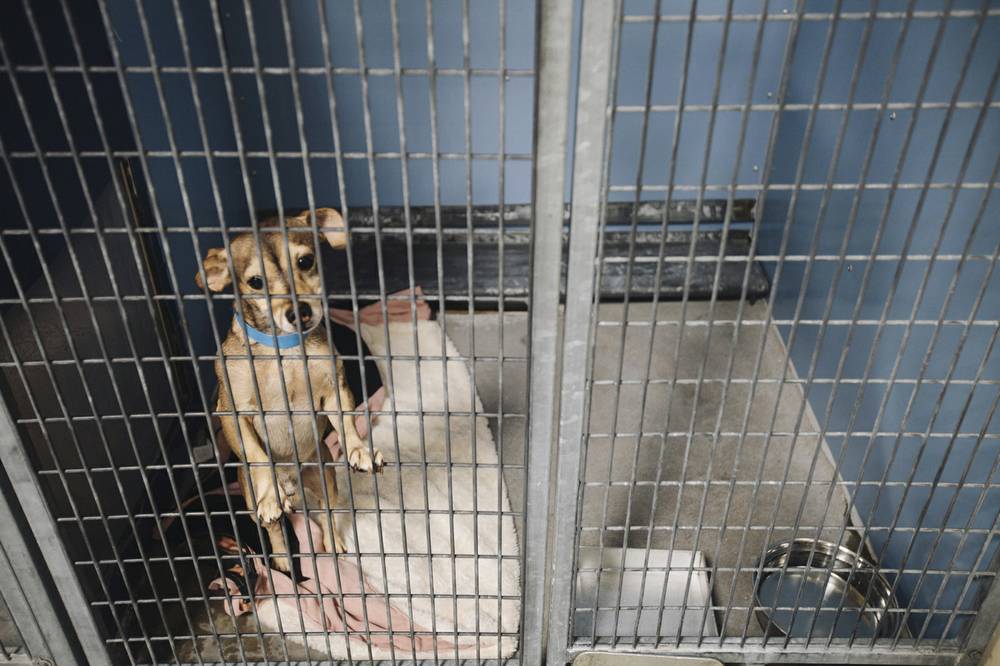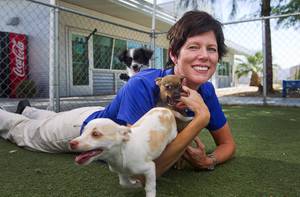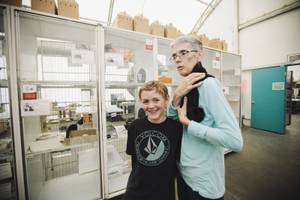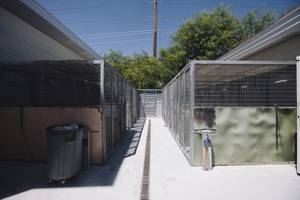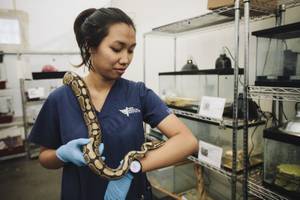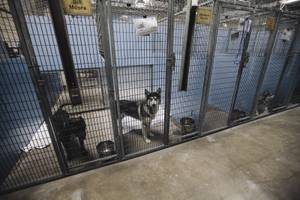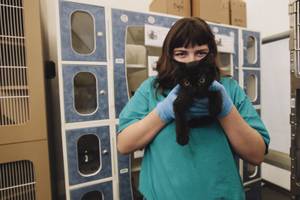They wait outside, some on leashes, another in a cardboard carrier, as their owners or acquaintances peer through the glass doors. It’s shortly before 10 a.m. at the receiving area of Lied Animal Shelter, ground zero for people wishing to surrender their pets, turn in a stray or find a beloved four-legged family member gone missing.
As workers unlock the doors, the group hustles inside. The receiving area’s manager, Delia Prol, offers a hearty, “Good morning!” and then asks the most optimistic question: “Is anyone looking for a lost animal?”
An older man steps forward. His cat is missing.
At the moment, he’s the only one in this room hoping to leave with an animal. Behind him, a young woman carries a drowsy-looking cocker spaniel she wants euthanized. She says the dog can’t walk anymore. Another lady drops off a stray cat. A third woman delivers an unleashed pug and a leashed mastiff that stands taller than her waist. She says she lost her house in foreclosure and her new landlord won’t allow dogs. She abruptly leaves without offering proof that the dogs are actually hers. Now the shelter must keep this odd pair for 72 hours—the amount of time strays are held for their owners to claim them. If no one comes looking, the nonprofit Animal Foundation, which operates the shelter, will evaluate the dogs’ health and behavior and determine their fate: available for adoption, placed in a temporary foster home to address a treatable illness, offered to a partner rescue organization, or euthanized for being too sick, lame or aggressive.
“Come on, handsome,” Prol says to the mastiff as she leads him back for processing.
Her cheerful encouragement is intentional. Shelter employees see firsthand the trauma animals endure when entering this foreign building. That’s why they play soothing classical music over speakers in rooms holding lost and stray animals.
“This isn’t family and this is not home,” Prol says of the shelter and the people who work and volunteer here. “It is very emotional for the animals.”
The Las Vegas Valley has a problem with domestic animals: We have more than we seem able or willing to handle, and those without homes mostly end up at the Lied Shelter. On any given day, it may be the single busiest animal holding facility in the nation. The Animal Foundation is contracted by Clark County and the cities of Las Vegas and North Las Vegas for more than $4 million annually to manage all the critters picked up by animal control officers. Lied gets about 100 to 120 animals daily, from animal control, owners surrendering their pets—either for adoption or euthanasia—and good Samaritans turning in strays (mostly cats and dogs, but occasionally chickens, snakes, rats, hamsters, peacocks and desert tortoises).
In 2013 alone, that equaled 40,348 animals.
Comparisons, even per capita ones, can be tricky, but there’s a general sense in the animal welfare community that the problem of untended animals is worse in Clark County than elsewhere in the nation. Some blame the recession, which led to the foreclosures of more than 150,000 homes in Clark County between January 2007 and May 2014, triggering wholesale abandonment of animals. Others blame government for lackluster enforcement of mandatory pet licensure and being slow to adopt spay/neuter laws. Still others believe the transient nature of our residents leads to apathy toward community issues like animal overpopulation.
Whatever the cause, more than 40,000 unwanted creatures entered the 8-acre Lied Shelter in Las Vegas last year. About half were eventually euthanized by a lethal injection, one by one by one … Officials there say this is an unfortunate necessity for a shelter that would otherwise run out of resources.
What can be done to kill fewer animals?
That question has been haunting the Animal Foundation for years. Now, finally, it looks like solutions may be attainable to allow the shelter to accomplish something local animal advocates have been dreaming of and working toward: turning Las Vegas into a no-kill community. Some of the proposals to get us there will raise eyebrows if not hackles. But this much is clear: If Las Vegas is going to euthanize only when absolutely necessary, it’s going to take everyone’s help.
The “no-kill” movement is defined as a community’s commitment to euthanize only those animals that are terminally ill or considered too dangerous. Every other animal, regardless of age, breed, color, minor disability or background, would be considered adoptable and worth saving. Using these criteria, the vast majority of animals that enter the country’s shelter systems are adoptable.
Some call the no-kill vision a pipe dream, especially for Las Vegas. Advocates point to other communities that have achieved it, thanks to their passion and comprehensive programs and services that attack pet homelessness from every angle. The official model, as outlined by the No Kill Advocacy Center, breaks it down into 11 steps or tenets. Half focus on stopping pets from entering the shelter in the first place. The others focus on using every available resource to get adoptable animals out alive.
The steps:
1. Partner with rescue groups
2. Enlist volunteers
3. Recruit foster homes providing temporary care
4. Promote trap-neuter-release programs to sterilize feral animals
5. Encourage people to keep their pets
6. Operate a comprehensive adoption program
7. Engage the community
8. Provide medical and behavior rehabilitation
9. Offer high-volume, low-cost spay and neuter clinics
10. Work proactively to return pets to owners
11. Employ a hard-working, compassionate shelter director
The no-kill philosophy has gained momentum over the past two decades, and locally the group No Kill Las Vegas has worked to raise awareness about the movement and to urge the Animal Foundation to do more to save animals.
The Animal Foundation’s executive director, Christine Robinson, says she embraces the no-kill movement, too. Indeed, the number of animals that have been put down at the Lied Shelter has decreased in recent years, for various reasons.
“We absolutely aspire to be no-kill,” Robinson says. “How can the answer to that ever be no? I won’t stop on that effort.”
But because of limited space, too few volunteers, an unsympathetic public and other limitations, today the Lied Shelter can’t pretend to be a no-kill facility. Most sick animals that are brought to the shelter, especially those with contagious upper-respiratory illnesses, are euthanized even though they could be treated if there were enough foster homes to house them or enough space at the shelter to segregate them. There is neither, so the shelter adopts “herd-health management”—removing the sick through euthanasia in order to protect the health of the larger animal population. Some sick animals are spared the death sentence by being passed on to partner rescue organizations or foster homes for the attention they need.
Despite the noble connotation of being a “no-kill” shelter, the confusing truth is how contentious the issue can be. The Humane Society of the United States and the American Society for the Prevention of Cruelty to Animals once held that euthanasia was a necessary evil. Now they embrace or support the no-kill philosophy to different degrees. On the other hand, People for the Ethical Treatment of Animals (PETA), an organization known for its extreme stances and publicity stunts on behalf of animal welfare, counter-intuitively maintains that euthanasia has its place, as distasteful as it may seem.
PETA believes no-kill policies promote dangerous hoarding of animals or result in animals being turned away from at-capacity shelters and ending up in even worse situations—killed inhumanely by their owners, given away via Craigslist to dog fighters who will use them as bait dogs, chained up and left for dead, or confined forever to a cramped cage in a warehouse where they’ll never again see sunlight. In other words, the animals are better off dead.
Daphna Nachminovitch, a former euthanasia technician and now senior vice president of cruelty investigations at PETA, explains: “We want to reach the same goal [as no-kill advocates] without endangering animals en route.” Referring to the Animal Foundation’s own past, Nachminovitch is quick to add, “Las Vegas is no stranger to this.”
The Animal Foundation was founded in 1978. Its Lied Shelter, a low-cost spay and neuter clinic, soon began offering shelter services. By the mid-’90s, it was the contracted shelter for the City of Las Vegas, handling more than 18,000 pets annually. Euthanasia rates for this period are unclear, but founding board member Janie Greenspun Gale, whose brother Brian Greenspun owns the Weekly’s parent company, says, “Euthanasia was a real shock to everybody. We were trying to adhere to the new no-kill movement.”
In 2006, the shelter entered into agreements with Clark County and the City of North Las Vegas, increasing the annual intake to 50,000 animals. According to the Animal Foundation, the organization’s board of directors and staff did “everything possible” to be no-kill, but the shelter was unprepared to handle the influx of animals.
“We crowded, and crowded, and crowded,” remembers Greenspun Gale. “[Animals] were getting sick, and we were adopting them out with medicine.”
At the foundation’s request, the Humane Society of the United States evaluated the struggling facility and then shut it down. In early 2007, more than a thousand animals were euthanized, mainly because they had contracted a highly contagious but preventable respiratory disease. The episode triggered public outrage. Robinson was hired shortly after in an attempt to rebuild. There was resignation that euthanasia would have to remain an unpleasant necessity.
The Humane Society and PETA praised the Animal Foundation’s decision and as recently as last fall expressed support for the steps the nonprofit has taken since 2006. The shelter’s current leaders point to both organizations’ support and the shelter’s failed effort to spare animals as evidence that a no-kill commitment isn’t feasible for Las Vegas right now.
Robinson has read the bullet points on the no-kill model and says she recently evaluated the Animal Foundation’s current policies and procedures against them. Partnerships with animal rescue groups to help find homes? The Animal Foundation has increased the number of animals transferred to some 70 rescue groups by 28 percent from 2012, to 2,644 in 2013. The Nevada SPCA takes about 100 dogs monthly, and animals are also transferred to Canada through a partnership with Foreclosed Upon Pets. Foster homes to provide temporary care for sick or young animals? The Animal Foundation recently added a full-time tech to that end, and has grown its foster roster to 337 families, caring for animals for an average of 28 days.
In fact, Robinson says that all of the data she’s looked at unquestionably trends toward saving more animals. Intake numbers are down 16.8 percent since 2010, from 48,496 to 40,348, a stat she and others in the animal welfare community attribute to comprehensive spay/neuter laws passed that year with strong Animal Foundation support. During that same three-year period, she says, there’s been a 31.7 percent decrease in the number of animals euthanized, from 31,007 to 21,183. Adoptions are up almost 11 percent from 2012, from 9,281 to 10,302.
All of that sounds good, but 21,183 dogs, cats and other animals—more than half of all the animals brought to the shelter—were still euthanized in 2013 alone.
Robinson concedes that a euthanasia rate hovering around 50 percent is nothing to be proud of.
“We will continue to lower that number,” she says, “but until the ability and willingness to positively place animals within the community matches the number of animals we take in, euthanasia is going to be a reality.”
Among the tactics she’s been focusing on—each of which involves community support—are:
• Better educating the community on the responsibilities of pet ownership, including the sterilization of animals. To that end, the Animal Foundation is working with the advertising and marketing firm R&R Partners on a pro-bono basis to create a multimedia education campaign.
• Enlisting more volunteers, especially ones to care for sick animals at home so they can be returned healthy to the shelter for adoption.
• Continued fundraising to pay for shelter improvements, especially the replacement of large tents with a permanent, public-friendly facility to better showcase cats and other animals for adoption. (Dogs are kept in 22 permanent bungalows, each with 12 one-dog kennels.)
“There are more animals than the citizens are able or willing to care for in their homes,” Robinson says. “We certainly have a role, a big role, but this problem needs to be solved by the community.”
With the right civic commitment, more can be done. For a shining example, just look north.
In early 2007, around the time Animal Foundation was euthanizing more than a thousand sick animals, the Nevada Humane Society, which operates the animal shelter contracted by Washoe County, made a public commitment to become a no-kill organization. By 2009, the save rate for dogs was about 90 percent, with a total intake of 7,752. The save rate for cats was 89 percent of 7,014—a 10 percent improvement over 2007.
The widely accepted criterion for being a no-kill shelter is a save rate of at least 90 percent. Nevada Humane Society achieved that status in 2010, and by the end of that year it even began importing animals from neighboring communities. Currently, its live-release rate sits at 95 percent with a total annual intake of 9,017 animals, while the national average as of 2009 was 58 percent.
Nevada Humane Society CEO Kevin Ryan says the Reno shelter aggressively follows the no-kill model, is innovative and taps widespread community support. It runs specials on adoption fees and off-site adoption events. It invests heavily in animal evaluation techniques, to assure the public that no dangerous animals are being adopted out. All possible space is utilized to house animals, and when the kennels are almost filled, alerts are sent to the shelter’s network of foster homes and volunteers and blasted over social media to spur more adoptions. (Some of these tactics are common in the shelter world; just last week, the Animal Foundation held an adoption fair for kittens in which fees were waived.)
The Reno community has supported the shelter’s no-kill effort, boosting volunteer ranks from 30 in 2006 to more than 7,000 today. By contrast, conventional shelters with higher euthanasia rates sometimes struggle to get volunteers. And while the Animal Foundation has just over 300 foster homes for animals needing special attention, the Reno community boasts 2,500.
“We empower our community,” says Ryan. “We say we need help, and they adopt. Our ability to move animals in one day is absolutely mind-boggling.”
The Nevada Humane Society went from 4,990 adoptions in 2006 to between 8,000 and 10,000 every year since. By comparison, the Animal Foundation adopted out 10,302 animals last year, in a county with a population about four times as large as Washoe County.
Comparisons between shelters will always be wobbly at best. Each community is different. Intake numbers, shelter structures and funding sources vary wildly, as do data reporting standards. “I think Washoe County is a special place,” Ryan says, “but a lot of communities can do this. I really think it’s about will, and investing in the right things.”
More around the country are starting to agree.
With the help of more than 150 local rescue groups and buy-in from then-Mayor Michael Bloomberg, New York City has seen dramatic decreases in euthanasia over the past decade. According to the Mayor’s Alliance for NYC’s Animals, 22,360 shelter animals found homes in 2013, a 77 percent live-release rate, compared to 11,947 animals, a measly 26 percent save rate, 10 years earlier. About two-thirds of the dogs and cats saved last year were transferred to rescue groups. Conversely, 31,701 animals were euthanized in New York City in 2003, compared with 6,124 last year (some of which were surrendered by owners to be put down).
On a smaller scale in Texas, after the Austin City Council embraced a no-kill plan in 2010, the number of pets euthanized at the open-intake Austin Animal Center decreased from 6,161 in fiscal year 2009 to 926 in fiscal year 2012, an 82 percent drop.
The key was adopting the best practices of other intake shelters, says Hilary Bentley, assistant to the executive director at Austin Pets Alive!, the largest of Austin City Council’s rescue partners.
“At first nobody trusted each other, and there were a lot of politics that overwhelmed the mission,” she says. “You just have to never give up. Ever.”
This moral commitment comes with a monetary cost. The year Austin hit the no-kill benchmark, the shelter budget jumped by more than $1 million to accommodate increased staffing, including a veterinarian and animal health technicians. The following year, in 2012, the shelter director had to ask the city for another $1 million in emergency funds. Where you fall on the issue of no-kill shelter reform could come down to whether you think this is an extravagant waste of money or simply the price of saving animals.
Robinson is sensitive to funding challenges. The Animal Foundation is asking Clark County and the cities of Las Vegas and North Las Vegas for an additional $13 million to renovate its deficient, 47,000-square-foot shelter building where animal control officers deliver animals, and the nonprofit has raised nearly $9 million in private donations toward a $15 million goal to construct a new cat shelter.
Would Clark County be willing to spend more tax dollars toward the cost of a larger, no-kill facility? County Commission Chairman Steve Sisolak isn’t sure.
“It would depend on how much more it would cost—we don’t know that—and how much could be raised philanthropically by the Animal Foundation,” Sisolak says. “And then we’d have to weigh the cost of our support against other pressing needs facing the county—things like child services, homelessness, meals for senior citizens. All these things would need to be prioritized.”
County Commissioner Chris Giunchigliani, an animal welfare advocate, worries that the Animal Foundation is being blamed for a problem not of its making—animal overpopulation—and says the responsibility rests with the community to be the first responders in addressing the issue.
“No-kill should be our ultimate goal, but our first goal should be to minimize and eliminate the overpopulation problem,” she says. “We need to educate the population, and I think we do that best by teaching our children how to be responsible pet owners. And I wish we could get our pet stores to post our spay/neuter law,” which requires animals be sterilized after four months of age, to put a halt to backyard breeding.
In her search for answers in reducing the euthanasia rate, Robinson recently invited veterinarian Kate Hurley, an animal shelter expert and no-kill advocate from the University of California, Davis, to reassess the Lied Shelter operations. Hurley had visited the overcrowded shelter in 2007 when so many dogs fell sick and were euthanized. Robinson also asked members of Humane Network, a nonprofit organization that consults communities on how to achieve no-kill goals, to weigh in.
Hurley and Humane Network’s leaders—both of whom had worked at the Nevada Humane Society and helped turn around Reno’s euthanasia rate—gathered at Lied in July to examine the facility and meet with staff, volunteers and local no-kill advocates who had criticized the Animal Foundation’s efforts.
Neither Hurley nor the Humane Network leaders are ready to reveal the specific recommendations they are preparing for the Animal Foundation. Any changes in how the Lied Shelter does business also would have to be approved by the county and two cities that contract it for animal control. But the consultants’ philosophies may telegraph what’s in store if Las Vegas is to become a no-kill community.
Some of the tactics were used in Reno, said Bonney Brown, who was executive director at the Nevada Humane Society from 2007 to 2013 before becoming president of the Humane Network.
Among them: Bombard social media with animal photos and stories. Make friends with the media. Reduce adoption fees and raise money instead by tapping philanthropists who embrace no-kill objectives. Hold events at the shelter so families grow comfortable visiting the animals. Discourage animal owners from surrendering pets at the shelter for health or behavior issues by offering advice in the lobby about how those problems can be addressed. And stress how an animal can bring comfort and joy to your life—in fact, become a best friend—as opposed to adopting an animal out of pity.
“I’m not at all critical of the Animal Foundation,” Brown says. “In fact, they’re doing as well if not better than most shelters.”
But Las Vegas is an enigma, Brown says: For some reason, we are less likely to adopt shelter animals than other communities. By her estimates, based in part on some statistical assumptions, Washoe County residents adopt 20 shelter animals per 1,000 people; Denver adopts about 12 animals per 1,000 people. Clark County’s rate: about 5 animals are adopted per 1,000 people. “There are plenty of homes in Las Vegas available for animals. Our job is to show people the opportunities.”
If Humane Network’s strategies seem reasonable, the philosophy held by UC Davis’ Hurley may seem extreme. It’s based on the assumption that the best way to attack the problem of crowded shelters is to reduce the number of animals entering them.
Hurley suggests that people who want to surrender animals must make appointments, thereby creating a manageable flow. If the person says feeding the animal has become too expensive, the shelter should provide free food. When an animal control officer picks up a dog, its license tag number should be entered into a computer to identify the dog’s owner, and then it should be returned that same day. If there is no license, take its photograph, create a “found” poster, immediately print copies in the truck and post them on neighborhood mailboxes. “There may be residents looking for their lost pit bulls and Chihuahuas who don’t even know of animal shelters but will see the posters,” Hurley says.
What about cats? That’s the real resource strain in Las Vegas, she says, based on an estimate of between 200,000 to 300,000 stray cats in the Valley. “It’s all but impossible for the shelter to take in 200 cats a day,” Hurley says. “And it’s useless because as soon as you remove 200 out of 300,000, they’ve bred that many kittens. We’re breaking our backs and our hearts trying to solve a problem that can’t possibly be solved.”
Unlike stray dogs that most likely are genuinely lost, most cats are not lost but simply ownerless, Hurley says. “At a shelter, the return-to-owner rate is five to 10 times higher for dogs than cats. If we can remove cats from the [shelter] equation, we’ll have more resources to manage the dogs. If a shelter does decide to take cats, then it should sterilize them and return them to where they were found.
“If someone reports a stray cat, don’t offer the service of picking it up and taking it to the shelter,” Hurley continues. “Instead, give the person a trap, explain how it works and leave information on the nearest neuter/spay clinic.”
Hurley says that when this strategy was presented to the Animal Foundation staff, “their eyes opened wide.”
The idea of not bringing stray cats into the shelter struck Robinson like an epiphany. “Discussing the cat initiative was the most exciting and inspiring piece of time we spent together,” she said of the meeting with Hurley and Humane Network. “We’re talking 12,000 cats a year—$960,000 spent on their care, feeding, housing and then euthanasia. Let’s spend those resources in ways that actually save dog lives. Heck yeah!”
Robinson now believes that a no-kill community is within reach. “We learned a lot from what happened in 2007. We adopted those recommendations. But now we’re hearing of ideas that haven’t been discussed before. It’s a paradigm shift. It’s time to take this to the next level.”
Jackie Valley and Tom Gorman contributed to this report.
Want to help?
If you're ready to get involved in animals' lives, here's what you need to know:
Volunteer
• The Animal Foundation had more than 900 volunteers in 2013, working on a wide variety of tasks and projects both at the shelter and off-site.
• Volunteers can sign up to spend quality time with the animals, work with dogs who need extra training, photograph adoptable pets and provide grooming, among other things.
• Prospective volunteers must attend an orientation session and complete training based on their preferred area of focus. There is a $10 fee for the official T-shirt and administrative expenses.
• When training is complete, volunteers enter a three-month “newbie” probationary period, during which they’re required to serve a minimum of six hours per month.
• After three months, there is no minimum hour requirement for volunteers. However, those who do not volunteer for a six-month period will be deactivated.
Foster
• Foster homes are a vital resource for the Animal Foundation, which placed 1,437 animals into foster care in 2013. Foster families take in pets that are too young to be adopted, are undergoing medical treatment or are not yet ready for adoption for other reasons.
• Most animals are in foster care for two weeks to two months, and the Animal Foundation’s Foster Coordinator works with those taking in animals to ensure that they always receive pets they’re comfortable housing.
• Potential fosters must fill out an application detailing their home environment, household pets, placement preferences and prior fostering experience, among other things.
• Foster parents must provide a litter box for cats, food bowls and toys, but food and medication is provided by the Animal Foundation.
• Foster parents commit to bi-weekly clinic visits to ensure the animals’ wellbeing, and renters must submit a letter of approval from their landlords.
• And, of course, should foster parents fall in love with the pet in their care, they’re welcome to adopt with the proper paperwork and once spay/neuter surgery is complete.
For more information on volunteering or fostering, visit animalfoundation.com/get-involved.
